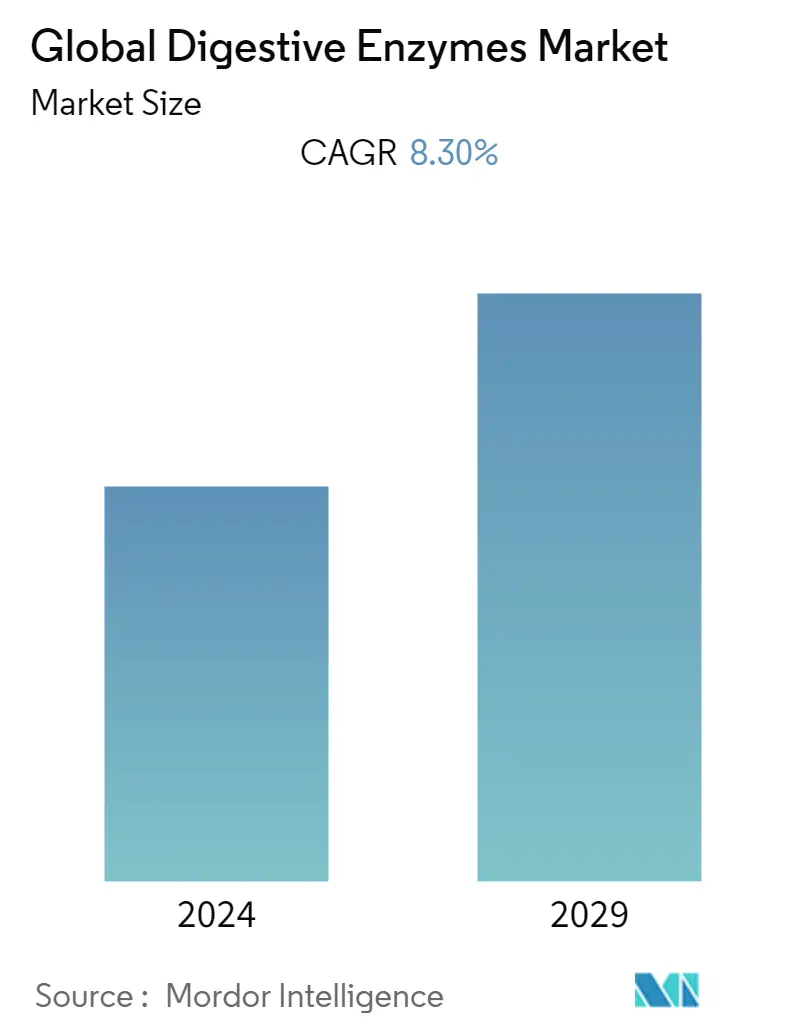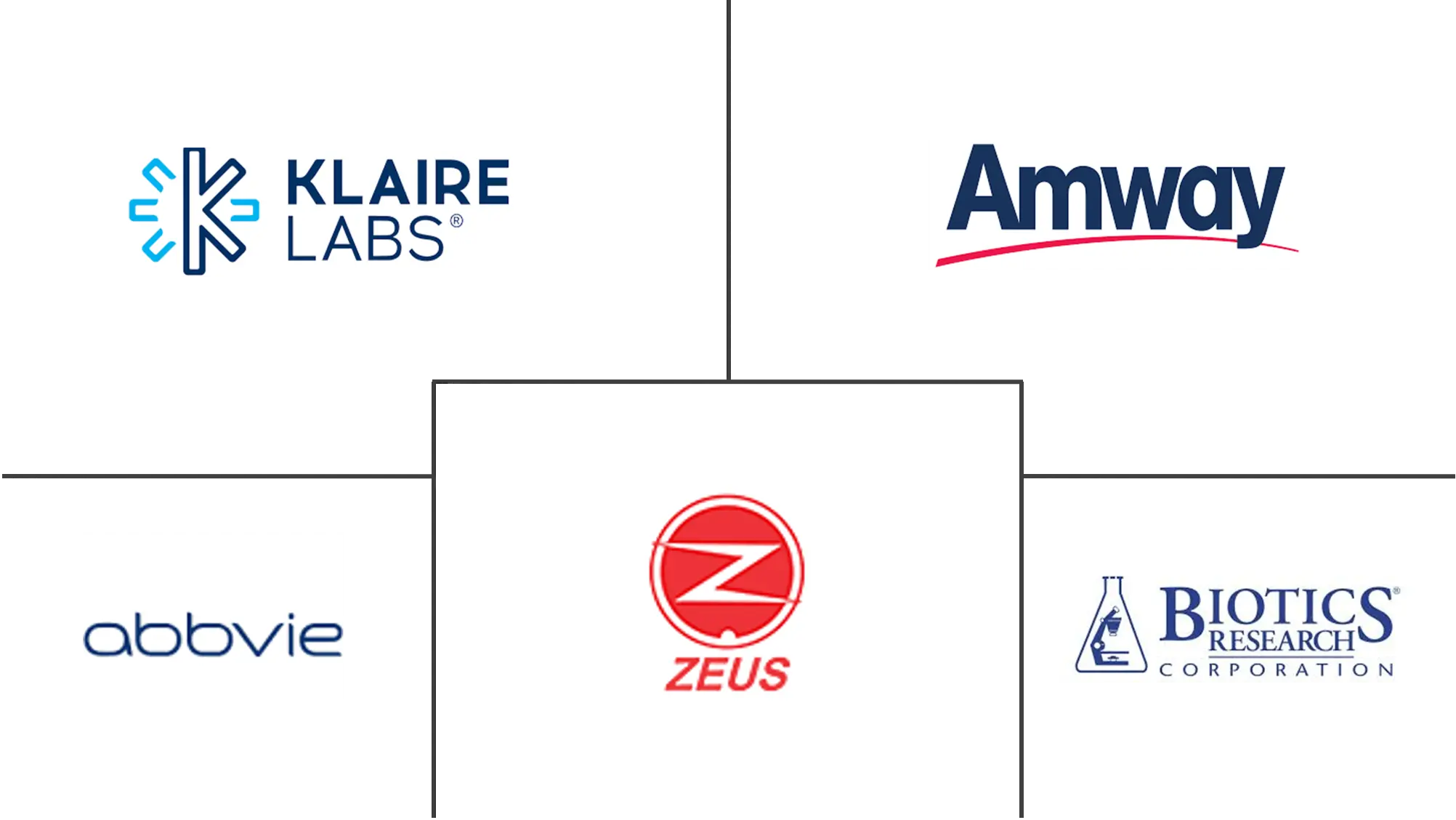Market Size of Global Digestive Enzymes Industry

| Study Period | 2019 - 2029 |
| Base Year For Estimation | 2023 |
| CAGR | 8.30 % |
| Fastest Growing Market | Asia Pacific |
| Largest Market | North America |
| Market Concentration | Low |
Major Players
*Disclaimer: Major Players sorted in no particular order |
Digestive Enzymes Market Analysis
The digestive enzymes market is expected to register a CAGR of 8.3% over the forecast period-2022-2027.
The novel coronavirus has significantly impacted all industries, including food and beverage, automotive, chemicals, and many others. This pandemic has resulted in mass production shutdowns and supply chain disruptions, which have affected the global economy. Thus, such factors adversely affected the market initially. However, increasing gastrointestinal symptoms among patients who have suffered from COVID-19 positively impacted the market in later times. According to the study titled, "Gastrointestinal symptoms associated with COVID-19: impact on the gut microbiome" published in December 2020, COVID-19 patients experienced gastrointestinal symptoms such as anorexia (17.9%), nausea (17.9%), and diarrhea (24.2%). It also reported that in patients who suffered severely from COVID-19, the symptoms of gastrointestinal disorders became more pronounced. Digestive enzymes help to break food substances for easy digestion. These proteins speed up chemical reactions that turn nutrients into substances so that the digestive tract can absorb. Thus, digestive enzymes are one of the essential element for treating gastrointestinal disorders. Therefore, such instances indicate that the market witnessed a positive impact during later times of the pandemic.
Factors such as the rising geriatric population, the rising prevalence of gastrointestinal disorders, increasing awareness about GI health, and focus on preventive health management are contributing to the market growth. The global population is aging rapidly, owing to reduced birth rates and rising life expectancy. The demographic trend toward an elderly population represents a rising need for the management of disorders, such as GI tract obstructions. According to the report published by the World Health Organisation in October 2021, the proportion of the population aged 60 and over will increase from 1 billion in 2020 to 1.4 billion in 2030. It also reported that by 2050, the world's population of people aged 60 and over will double around 2.1 billion. The secretion of digestive enzymes usually reduces with age that contributes to high levels of gastric discomfort, lower digestion rates, reduced food consumption, and/or a variety of other GI disorders. Therefore, with the rising elderly population, the market for digestive enzymes is expected to grow over the forecast period.
However, perception of probiotic and prebiotic products as alternatives to digestive enzymes and stringent regulatory policies are likely to hinder the market growth over the forecast period.
Digestive Enzymes Industry Segmentation
As per the scope of the report, digestive enzymes represent a group of enzymes secreted by the digestive organs to break down complex macromolecules into their constituents to facilitate their absorption by the body. Several digestive enzymes are commercially available as dietary supplements for the management of digestive disorders. The digestive enzymes market is segmented by enzyme type (Carbohydrase, Protease, Lipase, and Other Enzyme Types), origin (Animal, Microbial, and Plant), and geography (North America, Europe, Asia-Pacific, Middle-East and Africa, and South America). The market report also covers the estimated market sizes and trends for 17 different countries across major regions, globally. The report offers the value (in USD million) for the above segments.
| By Enzyme Type | |
| Carbohydrase | |
| Protease | |
| Lipase | |
| Other Enzyme Types |
| By Origin | |
| Animal | |
| Microbial | |
| Plant |
| Geography | ||||||||
| ||||||||
| ||||||||
| ||||||||
| ||||||||
|
Global Digestive Enzymes Market Size Summary
The digestive enzymes market is poised for significant growth, driven by factors such as an aging global population, increasing prevalence of gastrointestinal disorders, and heightened awareness of gastrointestinal health. The market experienced initial setbacks due to the COVID-19 pandemic, which disrupted supply chains and production. However, the pandemic also led to a rise in gastrointestinal symptoms among COVID-19 patients, subsequently boosting the demand for digestive enzymes as a treatment option. These enzymes play a crucial role in breaking down food substances, facilitating nutrient absorption, and managing gastrointestinal disorders. The market is further supported by the growing focus on preventive health management and the need for effective solutions to age-related digestive issues, as the secretion of digestive enzymes typically decreases with age.
North America is expected to lead the digestive enzymes market, driven by a substantial geriatric population and a high incidence of gastrointestinal disorders in the region. The presence of key market players, ongoing research, and strategic partnerships are contributing to the market's expansion in this area. The animal-origin digestive enzyme segment holds a significant share, with enzymes derived from swine, calf, and hogs being particularly effective in treating gastrointestinal conditions. Despite the market's growth prospects, challenges such as the perception of probiotics and prebiotics as alternatives to digestive enzymes and stringent regulatory policies may impede progress. The market remains fragmented, with numerous global and regional companies competing for market share, including notable players like AbbVie Inc., Klaire Labs, and Zeus Biotech Limited.
Global Digestive Enzymes Market Size - Table of Contents
-
1. MARKET DYNAMICS
-
1.1 Market Overview
-
1.2 Market Drivers
-
1.2.1 Rising Geriatric Population
-
1.2.2 Rising Prevalence of Gastrointestinal Disorders
-
1.2.3 Increasing Awareness about GI Health and Focus on Preventive Health Management
-
-
1.3 Market Restraints
-
1.3.1 Perception of Probiotic and Prebiotic Products as Alternatives to Digestive Enzymes
-
1.3.2 Stringent Regulatory Policies
-
-
1.4 Porter's Five Forces Analysis
-
1.4.1 Threat of New Entrants
-
1.4.2 Bargaining Power of Buyers/Consumers
-
1.4.3 Bargaining Power of Suppliers
-
1.4.4 Threat of Substitute Products
-
1.4.5 Intensity of Competitive Rivalry
-
-
-
2. MARKET SEGMENTATION (Market Size by Value - USD Million)
-
2.1 By Enzyme Type
-
2.1.1 Carbohydrase
-
2.1.2 Protease
-
2.1.3 Lipase
-
2.1.4 Other Enzyme Types
-
-
2.2 By Origin
-
2.2.1 Animal
-
2.2.2 Microbial
-
2.2.3 Plant
-
-
2.3 Geography
-
2.3.1 North America
-
2.3.1.1 United States
-
2.3.1.2 Canada
-
2.3.1.3 Mexico
-
-
2.3.2 Europe
-
2.3.2.1 Germany
-
2.3.2.2 United Kingdom
-
2.3.2.3 France
-
2.3.2.4 Italy
-
2.3.2.5 Spain
-
2.3.2.6 Rest of Europe
-
-
2.3.3 Asia-Pacific
-
2.3.3.1 China
-
2.3.3.2 Japan
-
2.3.3.3 India
-
2.3.3.4 Australia
-
2.3.3.5 South Korea
-
2.3.3.6 Rest of Asia-Pacific
-
-
2.3.4 Middle-East and Africa
-
2.3.4.1 GCC
-
2.3.4.2 South Africa
-
2.3.4.3 Rest of Middle-East and Africa
-
-
2.3.5 South America
-
2.3.5.1 Brazil
-
2.3.5.2 Argentina
-
2.3.5.3 Rest of South America
-
-
-
Global Digestive Enzymes Market Size FAQs
What is the current Global Digestive Enzymes Market size?
The Global Digestive Enzymes Market is projected to register a CAGR of 8.30% during the forecast period (2024-2029)
Who are the key players in Global Digestive Enzymes Market?
AbbVie Inc., Biotics Research Corporation, Klaire Labs, Amway Corporation and Zeus Biotech Pvt. Ltd. are the major companies operating in the Global Digestive Enzymes Market.

